How tight should your climbing shoes be on your feet and should they hurt while you are climbing? There are the types of questions you might be struggling with when in the market for your first or second pair of climbing shoes.
The answer isn’t that simple because if you made it simple, you might end up with the wrong fit.
If you google how climbing shoes should fit, you will find a divided crowd. Many climbers believe climbing shoes should be tight and hurt your feet, while other climbers proclaim that this is complete nonsense.
So which is it? Should climbing shoes hurt or not?
A lot of information surrounding the fit of climbing shoes is misleading.
This is because most youtube videos and articles are often way too broad.
Some climbers say you should downsize and others say you shouldn’t but the truth is, how much you will need to downsize depends on much more than that.
Criteria to fit climbing shoes
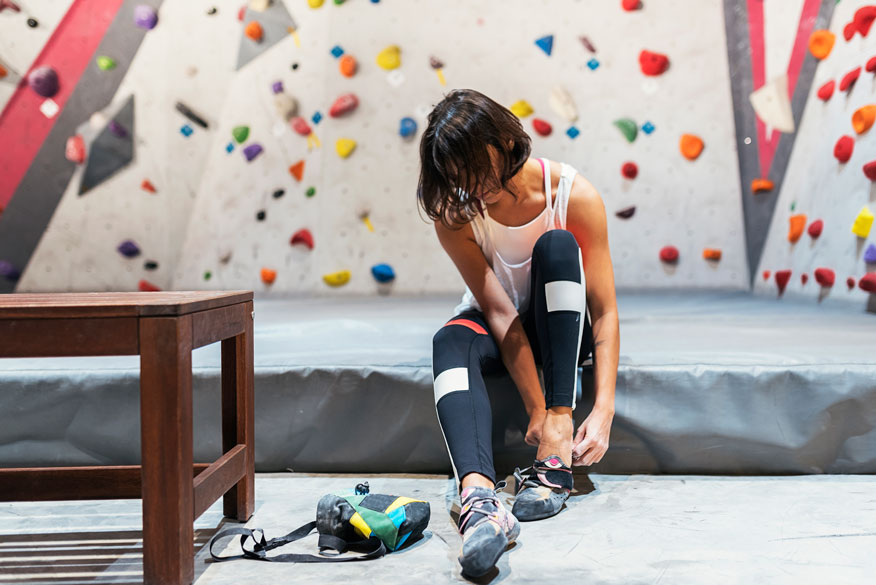
- What brand will you buy? La Sportiva shoes need to be downsized a lot whereas Ocun shoes don’t require that much downsizing at all.
- Are you getting stiff or soft shoes? Soft shoes require a much tighter fit than stiff shoes.
- What kind of climber are you? Boulderers and single-pitch climbers can size down a lot more than multi-pitch climbers.
- How experienced are you? A new climber has no experience with snug shoes and thus shouldn’t downsize much at all.
Do you see how it’s not that simple?
Following a random internet person’s advice to ‘just size down 2 from your street shoe’ isn’t going to help you find the right pair of climbing shoes.
And neither is an article or a youtube video that heavily swings one way or the other.
‘climbing shoes should hurt’ or ‘climbing shoes shouldn’t hurt’. It means nothing to you without the right context.
Alright, before we go into the fitting portion of this guide, let’s answer the question you came here for.
Should Climbing Shoes Hurt?
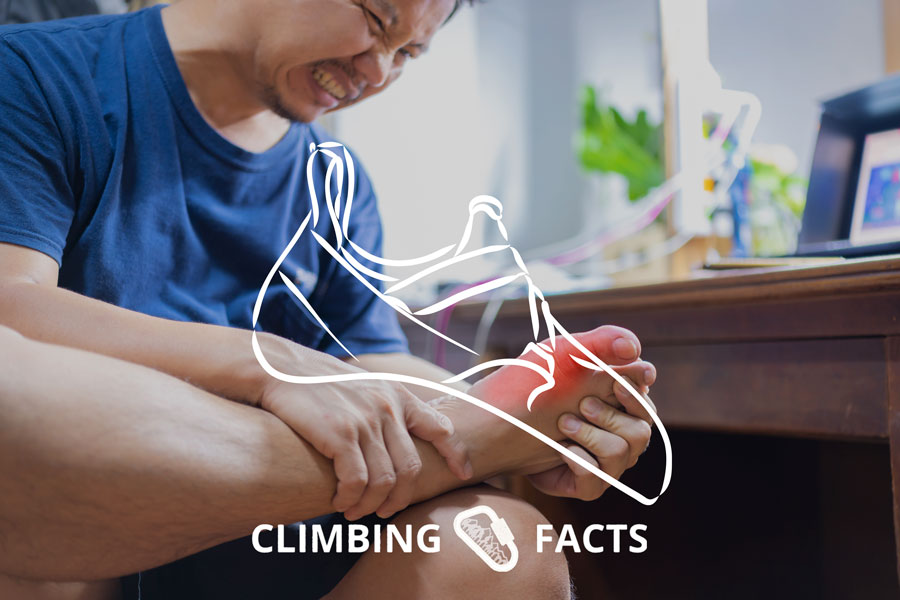
The right answer is that climbing shoes shouldn’t hurt once they are broken in. It is super important that you understand that climbing shoes will always hurt when you first try them on, as well as on your first couple of sessions.
If your climbing shoes are super comfortable right out of the box, they are definitely the wrong size. Once those puppies stretch, you will hate yourself for having bought them.
Here’s a real-life example of this happening…
I bought my first pair of climbing shoes online. La Sportiva Tarantulas. I went with the same size as my street shoe (38 EU) and when I first put them on, they felt very tight and even hurt a little. I thought this meant that I was in the clear and I had made the right purchase.
I purchased my first shoes based on the advice of others: don’t size down beginner climbing shoes.
After a couple of sessions, they stopped hurting when I put them on and after a month of bouldering, they became too big.
That’s right, my Tarantulas had stretched so much, I suddenly had air pockets, the toebox felt too roomy and my toes were completely flat inside my shoes. It felt like I was climbing with slippers on.
What happened is my climbing shoes stretched a lot during the break-in period. So these climbing shoes that hurt at first, were suddenly too big for me to properly climb in them.
What should I have done? I should have ordered more than one pair of shoes. Maybe this way, I would have realized that a 37 or 37.5 would have been a better fit for my first shoe. But I followed the advice of others and didn’t size down my shoes. After all, a beginner should never downsize their shoe, right? Or at least, that’s what we’re told.
In the case of La Sportiva (which are mainly leather shoes), you should downsize right away. I didn’t know that, and I paid the price.
Lesson learned. Climbing shoes should hurt a little bit right out of the box. And even if they do, they might still be too big for you once they are fully broken in.
Later on in this article, I’ll give you a sizing chart that includes the most popular brands and how to size them.
How tight should your climbing shoes be?
Your climbing shoes should be tight enough that there are no air pockets and your toes are at least slightly curled once they are broken in. If climbing shoes don’t hurt when you try them on, or you notice air pockets in the shop, they are definitely too big for you.
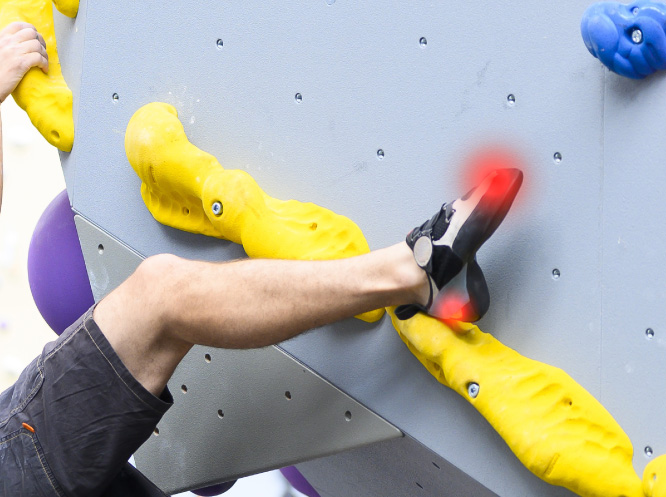
Having tight climbing shoes doesn’t mean that you should suffer in them though. If your shoes still hurt after weeks of wearing them, you most likely sized down too much.
Some boulderers and single-pitch climbers stand by this. They want their shoes to hurt while they are climbing.
How many climbers at your local bouldering gym take off their shoes after sending a problem? In most cases, these are expert-level climbers who have decided this is the way to go for them.
If you are reading this article, however, I’m going to assume you are in the beginner-intermediate spectrum and thus you should not be letting those people influence your decision process.
They didn’t size down their shoe 4 sizes from their street shoe in their first years of climbing, and neither should you.
Once you are ready to sacrifice your feet’s happiness, you will know for yourself and won’t need an article to tell you what to do.
For now, you should make sure your climbing shoes are tight enough that they hurt a little when you put them on for the first time, but not so much that you want to take them off after every problem.
In most cases, this will mean that you will need to size down 0.5 – 2 sizes from your street shoe size. How much you downsize, will largely depend on the brand and the materials used (which we will get into later).
Should your toes curl in climbing shoes?
It is a common misconception amongst beginner climbers that curled toes are a bad thing. This is because we tend to compare climbing shoes to our regular shoes, where a toe curl would definitely indicate that the shoe is too small.
This is not the case in the climbing world, however. Inside your climbing shoes, you should always have at least a slight toe curl. If your toes are completely flat inside your climbing shoes, they are probably too big.
Toe curls allow you to edge onto small holds. So unless you plan on stepping on jugs for the rest of your life, get a snug enough fit that your toes are curled inside your climbing shoes.
Even in beginner shoes, you should experience at least a slight toe curl. Once you opt for more downturned shoes (e.g. LS Otaki, LS Skwama, Scarpa Vapor V, etc) you will want to go for a tighter fit and a bigger toe curl.
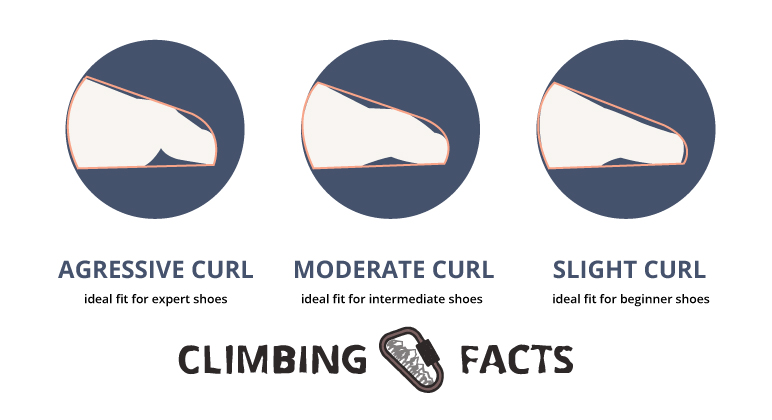
Read also: Different types of climbing shoes
How to Size Climbing Shoes
You’ve made it into the sizing portion of this article. To properly size your climbing shoes, we’ll go off the criteria we discussed earlier.
Here are the criteria once more:
- What brand will you buy?
- Are you getting soft or stiff shoes?
- What kind of climber are you?
- What is your level of experience?
TIP: Figure out your European Size first
If you plan to go for Scarpa or La Sportiva shoes, you should figure out what your European size is first. This will make sizing climbing shoes A LOT easier.
Here’s a conversion table to help you out:
US to EU men’s sizes
| EU | 36 | 37 | 37,5 | 38 | 38,5 | 39 | 39,5 | 40 | 40,5 | 41 | 41,5 | 42 | 42,5 | 43 | 43,5 | 44 |
|---|---|---|---|---|---|---|---|---|---|---|---|---|---|---|---|---|
| US | 4,5 | 5 | 5,5 | 6 | 6,33 | 6,5 | 7 | 7,5 | 7,66 | 8 | 8,5 | 9 | 9,5 | 10 | 10,33 | 10,5 |
US to EU women’s sizes
| EU | 35 | 35,5 | 36 | 37 | 37,5 | 38 | 39 | 39,5 | 40 | 41 |
|---|---|---|---|---|---|---|---|---|---|---|
| US | 4,5 | 5 | 5,5 | 6 | 6,5 | 7 | 7,5 | 8 | 8,5 | 9 |
Which brand are you eyeing?
Climbing shoe manufacturers have very different sizing standards. They are almost never 1-to-1 so you should keep this in mind when buying climbing shoes.
One way we can notice a difference in how manufacturers size their shoes is by looking at the mondopoint measurements they have given out.
Mondopoint Explained
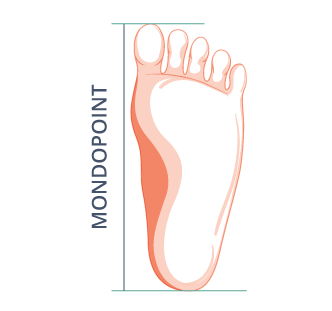
Mondopoint is a measuring system that relates to your foot measured in millimeters.
To measure your mondopoint: place your foot on a blank piece of paper. Next, draw a line at your big toe and another one at your heel. The distance between those lines is your mondopoint.
La Sportiva
| EU | 33 | 33,5 | 34 | 34,5 | 35 | 35,5 | 36 | 37 | 37,5 | 38 |
|---|---|---|---|---|---|---|---|---|---|---|
| Mondopoint (mm) | 210 | 214 | 217 | 221 | 224 | 227 | 230 | 236 | 240 | 243 |
Scarpa
| EU | 35 | 36 | 37 | 37,5 | 38 | 38,5 | 39 | 39,5 | 40 | 40,5 | 41 |
|---|---|---|---|---|---|---|---|---|---|---|---|
| Mondopoint (mm) | 210 | 225 | 230 | 235 | 240 | 243 | 245 | 250 | 255 | 257 | 260 |
Red Chilli
| EU | 33 | 34 | 34,5 | 35 | 35,5 | 36 | 37 | 37,5 | 38 | 38,5 | 39 |
|---|---|---|---|---|---|---|---|---|---|---|---|
| Mondopoint (mm) | 200 | 205 | 210 | 215 | 220 | 225 | 230 | 235 | 240 | 245 | 250 |
As you can see for size 35 EU, La Sportiva gives out a mondopoint of 224mm. However, both Scarpa and Red Chilli give the same mondopoint measurement (225mm) to a size 36.
This indicates that La Sportiva shoes should be sized down one more size than Scarpa or Red Chilli shoes.
Soft or stiff shoes?
When it comes to climbing shoes, you have soft and stiff shoes. The softness or stiffness of a climbing shoe refers to the flexibility of the shoe. A soft shoe has a thinner layer of rubber on the bottom of the shoe allowing for more flexibility. A stiff shoe has a thicker layer of rubber allowing for more durability.
Stiff shoes offer a lot of support.
Soft shoes on the other hand require your toes to work harder, making them more precise but also making them work so hard that they will tire out much faster.
For this reason, stiff shoes are mainly used for outdoor settings, especially during multi-pitch and big wall climbing. Soft shoes on the other hand are common in bouldering and single-pitch climbing.
Soft shoes are really good at smearing, volumes, and clawing down on footholds in overhung terrain. Stiff shoes are great at edging on small footholds and cracks.
Stiff shoes are also very common in climbing shoes oriented toward beginners (e.g. La Sportiva Tarantula). The stiffer sole is beneficial to beginners as it won’t be as tough on their toe muscles and ligaments. Furthermore, their feet won’t get tired as quickly.
However, some manufacturers (such as Scarpa) have started stepping away from stiff soles in beginner’s shoes in favor of softer beginner shoes. One such example is the Scarpa Veloce, a beginner shoe with soft rubber that is designed specifically for indoor climbing.
UPDATE: even La Sportiva followed this trend more recently by re-designing the Tarantula for bouldering with less rubber and a split sole for a much better indoor bouldering experience.
Whether this will become the pathway of the future for beginner climbers, is yet to be determined.
If your style of climbing suits a stiffer shoe, you are going to require a less tight shoe. In a stiff shoe, you shouldn’t have more than a slight toe curl. If you plan to opt for a softer shoe with a more aggressive downturn you will have to downsize your shoes and curl your toe appropriately.
Which kind of climber are you?
There are many branches in climbing, and defining your style of climbing is essential to picking out the right climbing shoe and sizing it correctly.
If you are a boulderer, you can size down more than a sport climber. And as a sport climber, you can size down more than a trad climber.
In other words, deciding your climbing shoe size will largely depend on how long you will be wearing the shoes.
That being said, just because you are a boulderer doesn’t mean you should size down so hard that you will experience discomfort every time you put your shoes on. This masochistic behavior is reserved for the experts.
So unless climbing is everything to you and you are willing to sacrifice your feet for your lifestyle, go tight but not too tight.
What is your level of experience?
Finally, you want to determine your level of experience as a climber when sizing your shoes.
Not only will this impact which climbing shoes you buy (as there are beginner, intermediate, and advanced climbing shoes on the market) it will also impact how much you will size down from your shoe street size if you will even size down at all.
As a beginner climber, you will most likely just purchase a climbing shoe based on your street shoe size (unless you opt for a brand like La Sportiva, but we’ll get into that later).
So what is your level of experience?
For bouldering:
- Beginner boulderer: V0 – V2 (4 – 5+)
- Intermediate boulderer: V3 – V5 (6a – 6b)
- Advanced boulderer: V6 – V8 (7a – 7b+)
- Expert boulderer: V9 – V12 (7c – 8a+)

Read also: boulder grading conversions
For sport climbing:
- Beginner climber: 5.2 – 5.9
- Intermediate climber: 5.10a – 5.11d
- Advanced climber: 5.12a – 5.13d
- Expert climber: 5.14a and above
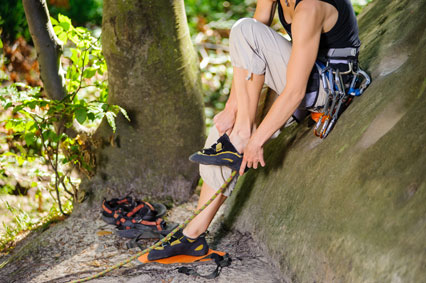
Climbing Shoe Sizing Chart by Brand
Below you’ll find a sizing chart for popular brands of climbing shoe manufacturers categorized for the three levels of climbers: beginner, intermediate and advanced.
You can use this chart to find your ideal climbing shoe size. You should preferably still fit your shoes in a local climbing store (e.g. an REI) or order from a site with a good return policy.
Remember what you learned:
- New climbing shoes will always hurt at first, they will stretch out later
- Your toes should be curled inside your climbing shoes
- Not every brand uses the same sizing
Sizing for Beginner Climbing Shoes
| Climbing Shoe Manufacturer | Size related to street shoe size |
|---|---|
| La Sportiva | 0.5 size smaller |
| Scarpa | same as street shoe |
| Red Chilli | same as street shoe |
| Ocun | same as street shoe |
| Mad Rock | 0.5 size bigger |
| Tenaya | same as street shoe |
Sizing for Intermediate Climbing Shoes
| Climbing Shoe Manufacturer | Size related to street shoe size |
|---|---|
| La Sportiva | 1 – 1.5 size smaller |
| Scarpa | 1 size smaller |
| Red Chilli | 0.5 size smaller |
| Ocun | 0 – 0.5 size smaller |
| Mad Rock | 0 – 0.5 size smaller |
| Tenaya | 0.5 – 1 size smaller |
Sizing for Advanced Climbing Shoes
| Climbing Shoe Manufacturer | Size related to street shoe size |
|---|---|
| La Sportiva | 2(+) size smaller |
| Scarpa | 1.5 size smaller |
| Red Chilli | 1 – 1.5 size smaller |
| Ocun | 1 size smaller |
| Mad Rock | 0.5 – 1 size smaller |
| Tenaya | 1.5 – 2 size smaller |
The sizing chart was made using my personal experience, in combination with the calculator by Bergfreunde, r/climbing users on Reddit, forum members on mountainproject, individual sizing charts provided by manufacturers, and sizesquirrel.
How to use the Climbing Shoe Chart
The chart above should be used as a reference to find your ideal climbing shoe, but it shouldn’t be used religiously.
Just because the chart says your ideal size is a 35 in La Sportiva, doesn’t mean that is the case. But it is a good starting point.
So go to your local climbing shop and try out a 35 in the shoe you were eyeing.
How does it feel? Does it feel tight? Does it hurt a little? That’s good.
If it feels too painful and you are a beginner, that might be an indication to size up.
On the other side of the spectrum, if you have any doubts at all whether they might be too big (air pockets, they don’t hurt, they don’t feel tight) that is a for sure sign that you should size down more.
Again, keep in mind that the shoes will stretch. Some climbing shoes (e.g. La Sportiva Skwamas) can stretch a whole size and trust me, you will regret not buying those a little too tight.
How to buy Climbing Shoes Online
If for some reason you don’t have access to a climbing store to fit your shoes, buying online is still a perfectly viable option.
I recommend that you look for an online store that has an amazing return policy with preferably free returns.
To check for the return policy, you’ll want to scroll all the way down to the footer of the website.

Inside the return policy you will find out exactly how long you have to decide as well as how much it will cost you. For example, on Bergfreunde you have 100 days to decide and you can return your package for 3.95 EUR.
Ideally, you will order the shoe in three different sizes based on our climbing chart:
- One size smaller than recommended
- The size that is recommended
- One size bigger than recommended
This way you can test all three and this should be enough to find the best fit between the three. If you don’t know the site you are ordering from, and don’t trust their return policy, stick to the size that is recommended.
Online climbing store shoes that I recommend:
- Bergfreunde.eu: best for Europeans
- REI: best for Americans
- Bananafingers: best for UK citizens
Climbing Shoe Fit – Frequently Asked Questions
What’s the difference between men’s and women’s shoes?
Climbing shoes often come in two styles: a men’s and a women’s version. The women’s version will have a lower volume meaning a slightly smaller toebox but the biggest difference lies in the heel which is smaller as well as women’s shoes accommodate for a higher arch.
If you are a female climber with narrow feet, you will most likely find a better fit in the women’s version of your preferred climbing shoe. Same with men who have narrow feet and a smaller heel.
Myself included, I tend to opt for women’s shoes instead of men’s shoes as my feet are quite narrow. So yes, it is perfectly fine for men to wear women’s shoes.
Even when trying on shoes in a shop, a real climbing expert will hand you women’s shoes if they notice your heel is on the smaller side.
Should I wear socks in climbing shoes?
Since climbing shoes are meant to be worn tight, you shouldn’t wear socks in them. Going barefoot will allow for more sensitivity and better footwork when climbing. It’s a no-brainer really.
Especially if you paid a serious penny for your climbing shoe, don’t size them up simply so you can wear socks underneath.
The only time you should wear socks in climbing shoes is if you are using rental shoes (for obvious reasons).
How long does it take to stretch out climbing shoes?
Depending on the type of shoe, it can take anywhere from a couple of sessions to a couple of months to fully stretch out your climbing shoe.
Conclusion
That’s everything I can teach you about how to fit your climbing shoes. They should feel tight and hurt a little when you first try them on, they will stretch out and become more comfortable later on. Remember: your toes should always be curled inside your climbing shoe. This is what allows you to really claw down!
For the best possible fit, use our sizing chart. They are a great reference when getting beginner, intermediate, or even performance climbing shoes. Don’t use the chart religiously though, your feet are different from others and thus you should still fit multiple shoes before settling on a pair.
Continue Reading
More articles from climbingfacts
- Indoor Bouldering Basics: intro to gym climbing
- Tips for short climbers
- Complete Guide to Bouldering Grades (& conversions)
- How to start and finish a boulder problem
- Can I get abs from climbing?
- Bouldering vs rock climbing
- How often you should go bouldering per week
- Why bouldering is a good full-body workout
- Climbing 101: what is cutting feet?
- How long does it take to progress in bouldering?
- How much does it cost to start bouldering?
- What to wear indoor bouldering
- How much of a bouldering wall can you use?
- Should climbing shoes hurt?
- How many climbing shoes do you really need?
- Yoga for climbers
- Core workout for climbers